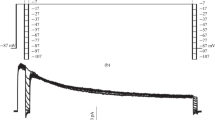Abstract
The effects of 4-aminopyridine, verapamil, and 4-bromophenacylbromide (4-BPB) on the kinetics of delayed outward-rectifying potassium currents (I K) were investigated in cultured mouse peritoneal macrophages using a classical whole-cell patch-clamp technique. The outwardI K was completely blocked by 4-aminopyridine at 1.0 mM concentration. Verapamil at the same concentration also blockedI K completely. Lower concentration (50 µM) of verapamil demonstrated only partial blocking action, which was almost fully reversible, and markedly increased the rate ofI K inactivation. The main effect of 4-BPB on the outwardI K was a significant acceleration ofI K activation and inactivation kinetics. It is suggested that this modulation results from a direct effect of 4-BPB on potassium channels or relates to the arachidonic acid cascade.
Similar content being viewed by others
References
D. L. Ypey and D. E. Clapham, “Development of a delayed outward-rectifying K+ conductance in cultured mouse peritoneal macrophages,”Proc. Natl. Acad. Sci. USA,81, 3083–3087 (1984).
B. Jow and D. G. Nelson, “Outwardly rectifying K+ current as a marker of cellular activation in human macrophages,”Biophys. J., 55, 539a (1989).
D. G. Nelson, B. Jow, and K. J. Popovich, “Whole-cell current in macrophages. II. Alveolar macrophages,”J. Membrane Biol.,117, 45–55 (1990).
O. P. Hamill, A. Marty, E. Neher, et al., “Improved patch-clamp techniques for high-resolution current recording from cell-free membrane patches,”Pflügers Arch.,391, 85–100 (1981).
K. G. Chandry, T. E. De Coursey, M. D. Cahalan, et al., “Voltage-gated potassium channels are required for human T-lymphocyte activation,”J. Exp. Med.,160, 369–385 (1984).
T. E. De Coursey, K. G. Chandy, S. Gupta, and M. D. Cahalan, “Voltage-gated K+-channels in human T-lymphocytes: a role in mitogenesis,”Nature,307, 465–468 (1984).
E. K. Gallin and P. A. Sheehy, “Differential expression of inward and outward potassium currents in the macrophage-like cell line J 774.1,”J. Physiol.,369, 475–499 (1985).
E. K. Gallin, “Ion channels in leukocytes,”Physiol. Rev.,71, 775–811 (1991).
D. G. Nelson, B. Jow, and F. Jow, “Whole-cell currents in macrophages. I. Human monocyte-derived macrophages,”J. Membrane Biol.,117, 29–44 (1990).
D. G. Nelson, L. Rufer, T. Nakayama, and J. M. Zeller, “Phorbol ester block of voltage-dependent K+ current in monocyte-derived macrophages,”Biophys. J., 49, 164a (1986).
C. Randriamampita and A. Trautmann, “Ionic channels in murine macrophages,”J. Cell Biol.,105, 761–769 (1987).
R. E. Sheridan and B. M. Bayer, “Ionic membrane currents induced in macrophages during cytolysis,”Fed. Proc., 45, 1009a (1986).
M. D. Cahalan, K. G. Chandy, T. E. De Coursey, and A. Gupta, “A voltage-gated potassium channel in human T lymphocytes,”J. Physiol.,358, 197–237 (1985).
W. A. Scott, N. A. Pawlovsky, H. W. Murray, et al., “Regulation of arachidonic acid metabolism by macrophage activation,”J. Exp. Med.,155, 1148–1160 (1982).
T. A. Hamilton and D. O. Adams, “Molecular mechanisms of signal transduction in macrophages,”Immunol. Today,8, 151–158 (1987).
G. P. Brown, M. M. Monick, and G. W. Hunninghake, “Human alveolar macrophage arachidonic acid metabolism,”Am. J. Physiol.,254, 809–815 (1988).
M. Laviolette, M. Carreau, R. Coulombe, et al., “Metabolism of arachidonic acid through the5-lipoxygenase pathway in normal peritoneal macrophages,”J. Immunol.,141, 2104–2109 (1988).
M. Giordano, J. R. Geffner, A. Prat, et al., “Cyclophosphamide modulates arachidonic acid metabolism by peritoneal macrophages,”Int. J. Immunopharmacol.,10, 939–944 (1988).
W. Kander and R. Sundler, “Macrophage arachidonate-mobilizing phospholipase A: role of Ca++ for membrane binding but not for catalytic activity,”Biochem. Biophys. Res. Commun.,184, 118–124 (1992).
R. F. Irvine, “How is level of free arachidonic acid controlled in mammalian cells,”Biochem. J.,204, 3–16 (1982).
Author information
Authors and Affiliations
Additional information
Neirofiziologiya/Neurophysiology, Vol. 26, No. 1, pp. 49–53, January–February, 1994.
Rights and permissions
About this article
Cite this article
Krutetskaya, Z.I., Lebedev, O.E. & Roshchina, N.G. Delayed-rectifying potassium channels in mouse peritoneal macrophages: Pharmacological analysis. Neurophysiology 26, 40–44 (1994). https://doi.org/10.1007/BF01059992
Received:
Issue Date:
DOI: https://doi.org/10.1007/BF01059992




